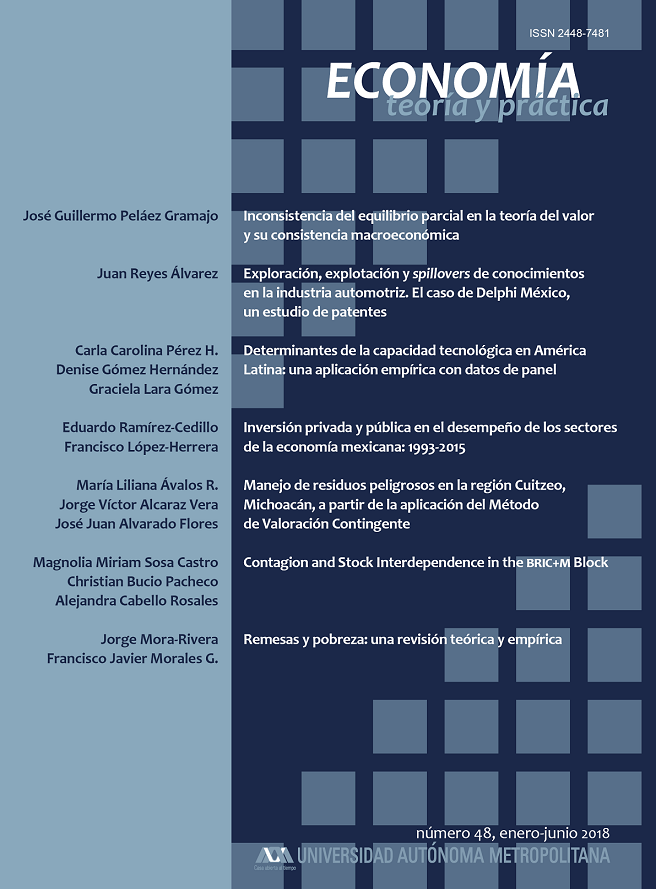- Contagion Effect,
- Stock Dependence,
- BRIC M block

This work is licensed under a Creative Commons Attribution-ShareAlike 4.0 International License.
Abstract
This paper aims to analyze the contagion effect among the stock markets of the BRIC+M block (Brazil, Russia, India, China plus Mexico). The contagion effect is proved through increases on dependence parameters during crisis periods. The dependence parameters are estimated through a dynamic bivariate copula approach for the period July 1997 to December 2015. During this period there were instability and calm episodes, which allow analyzing changes in the relations of dependence. Empirical results show strong evidence of time-varying dependence among the BRIC+M markets and an increasing dependence relation during the global financial crisis period.
References
- Ahmad, Wasim; Sehgal, Sanjay & Bhanumurthy, N. R. (2013), “Eurozone crisis and briicks stock markets: Contagion or market interdependence?”, Economic Modelling, 33, pp. 209-225.
- Alexakis, Panayotis; Kenourgios, Dimitris & Dimitriou, Dimitrios (2016), “On emerging stock market contagion: The Baltic region”, Research in International Business and Finance, 36, pp. 312-321.
- Bekiros, Stelios D. (2014), “Contagion, decoupling and the spillover effects of the US financial crisis: Evidence from the bric markets, International review of financial analysis, 33, pp. 58-69.
- Bergmann, Daniel Reed; Securato, José Roberto; Ferreira Savoia, José Roberto & Contani, Eduardo Agusto Do Rosário (2015), “US subprime financial crisis contagion on bric and European Union stock markets, Revista de Administração (São Paulo), 50 (2), pp. 229-240.
- Bianconi Marcelo; Yoshino, Joe Akira & De Sousa, Mariana O. Machado (2013), “bric and the US financial crisis: An empirical investigation of stock and bond markets”, Emerging Markets Review, 14, pp. 76-109.
- Changqing, Lou; Chi, Xie; Cong, Yu & Yan, Xu (2015), “Measuring financial market risk contagion using dynamic mrs-Copula models: The case of Chinese and other international stock markets”, Economic Modelling, 51, pp. 657-671.
- Chen, Wang; Wei, You; Lang, Qiaoqi; Lin, Yu & Liu, Maojuan (2014), “Financial market volatility and contagion effect: A copula–multifractal volatility approach”, Physica A: Statistical Mechanics and its Applications, 398, pp. 289-300.
- Chittedi, Krishna Reddy (2014), “Global Financial Crisis and Contagion: Evidence for the ‘bric’ Economies”, The Journal of Developing Areas, 48 (4), pp. 243-264.
- Claessens, Stijn; Dornbusch, Rudiger and Park, Yung Chul (2000), “Contagion: understanding how it spreads”, The World Bank Research, 15 (2), pp. 177-197.
- Dewandaru, Ginanjar; Masih, Rumi & Masih, A. Mansur M. (2015), “Why is no financial crisis a dress rehearsal for the next? Exploring contagious heterogeneities across major Asian stock markets”, Physica A: Statistical Mechanics and its Applications, 419, pp. 241-259.
- Fenech, Jean Pierre; Vosgha, Hamed & Shafik, Salwa (2015), “Loan default correlation using an Archimedean copula approach: A case for recalibration”, Economic Modelling, 47, pp. 340-354.
- Forbes, Kristin J. & Rigobon, Roberto (2002), “No contagion, only interdependence: measuring stock market comovements”, The journal of Finance, 57 (5), pp. 2223-2261.
- Grover, Vaibhav (2015), Identifying Dependence Structure among Equities in Indian Markets using Copulas.
- Jayech, Selma (2016), “The contagion channels of July–August-2011 stock market crash: A dag-copula based approach”, European Journal of Operational Research, 249 (2), pp. 631-646.
- Kotz, Samuel; Johnson, Norman L. y Balakrishnan, Narayanaswamy (1972), Distributions in Statistics: Continuous Multivariate Distributions, United States of America, John Wiley & Sons, inc.
- Luchtenberg, Kimberly F. and Vu, Quang Viet (2015) “The 2008 financial crisis: Stock market contagion and its determinants”, Research in International Business and Finance, 33, pp. 178-203.
- Mostafa, Maria Zakia Papanikolaou and Stavroyiannis, Stavros (2016), “bric dynamic conditional correlations, portfolio diversification and rebalancing after the global financial crisis of 2008-2009”, Global Business and Economics Review, 18 (1), pp. 28-40.
- Neaime, Simon (2016), “Financial crises and contagion vulnerability of mena stock markets”, Emerging Markets Review.
- Nguyen, Cuong Cao and Bhatti, Ishaq (2015), “Tail Contagion: Were Vietnam and China Stock Markets Out of the US Mortgage Crisis?”, Available at ssrn 2647675.
- Ortiz, Edgar; Bucio, Christian and Cabello, Alejandra (2016), “Dependence and Value at Risk in the Stock Markets from the Americas: A Copula Approach”, Journal of Research in Business, Economics and Management, 5 (5), pp. 761-780.
- Romero-Meza, Rafael; Bonilla, Claudio; Benedetti, Hugo and Serletis, Apostulos (2015), “Nonlinearities and financial contagion in Latin American stock markets”, Economic Modelling, 51, pp. 653-656.
- Shen, Pei-Long; Li, Wen; Wang, Xiao-Ting and Su, Chi- Wei (2015), “Contagion effect of the European financial crisis on China’s stock markets: Interdependence and pure contagion”, Economic Modelling, 50, pp. 193-199.
- Singh, Amanjot and Kaur, Parneet (2014), “Impact of the Fii’s Indian Equity Investment Behavior on the Bric Countries’stock Market Volatility during the Subprime Crisis. An Empirical Investigation”, Journal of Academic Research in Economics, 6 (3).
- Sosa, Miriam; Bucio, Christian and Cabello, Alejandra (2015), “Mercados de Capitales del Bloque Bric+ México: dependencia estimada con un enfoque de cópulas”, Investigación Administrativa, 44 (115), pp. 70-86.
- The Role of brics in the developing world, Office for Official Publications of the European Communities, 2012.
- Verma, Rajneesh Prakash and Rani, Poonam (2015), “Transmission of Stock Price Movement: An Empirical Analysis of bric Nations for the Post-2008 Financial Crisis Period”, iup Journal of Financial Risk Management, 12 (3), p. 29.


